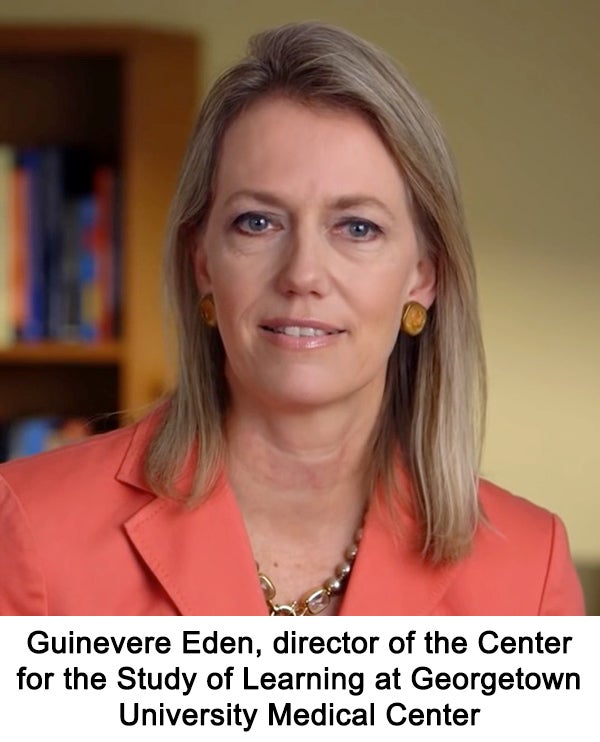Researcher Analyzes Potential Connection Between Reading and Math Disabilities

Posted in GUMC Stories | Tagged brain, dyscalculia, dyslexia
(February 16, 2018) — Dyslexia, a developmental reading disability that occurs when children have difficulty learning to decode words, affects 5–12 percent of children. At the same time, 6–14 percent of youngsters are affected by the math disability dyscalculia, the term for difficulty understanding numbers, learning how to manipulate them and learning facts in mathematics.
Children with dyslexia are more likely to have dyscalculia than children who do not. Exactly how these disabilities are linked, or even if they are, is the question that Guinevere Eden, D.Phil., is taking on. She says the answer matters because both reading and math are important in everyday activities, and both affect educational and vocational outcomes.

In March, Eden, director of the Center for the Study of Learning at Georgetown University Medical Center, will start a four-year study that examines brain function in children with math disability, and compares these children with those who have reading disability, as well as those with math and reading disability combined. Her team will use brain imaging and behavioral tests. Not only will the groups be compared to each other, but the groups will be followed after receiving interventions (tutoring).
The $1.7 million grant supporting the research was one of the first awarded under the READ Act, signed by President Barack Obama in 2016, and granted to Eden and her colleagues by the National Science Foundation (NSF) (grant #1743521). READ stands for Research Excellence and Advancement for Dyslexia (H.R. 3033), and it is designed to help the many children with dyslexia, as well as to improve detection of what is believed to be an under-diagnosed and undertreated condition.
“We are delighted to take this new step in our long effort to understand learning differences,” says Eden, who is also a professor in the department of pediatrics. “I believe this research will provide a critical piece to this puzzle, because while we have already put together a number of pieces, the big picture isn’t yet clear.”
Reading intervention increases gray matter
Since 1996, Eden has studied learning disability with functional magnetic resonance imaging (fMRI) to look at how the brain operates in children and adults with these challenges. The summer tutoring sessions for the children in the new study are intense — 6 hour camps, every day of the week, for six weeks. The intervention is delivered by tutors, funded by the NSF award, and takes place at local schools.
Her work has progressively revealed the roots of both reading and math disabilities. In 2011, for example, Eden was the senior author on a study published in NeuroImage, which examined changes in gray matter volume following intensive reading intervention in children with dyslexia. The study showed, for the first time, that reading improvements induced by intervention are accompanied by increases in brain gray matter, and that behavioral and structural brain changes were maintained after the intervention stopped. Gray brain matter contains the brain’s neuronal cell bodies.
A 2014 study, also in NeuroImage, was the first to identify patterns of brain activity that link dyslexia to difficulty with math, even though some of the study’s participants did not meet the criteria for a formal math disability. Eden was the senior investigator. “We can see from imaging studies that children with dyslexia use the brain in a different way to do math problems. They have trouble with addition because it relies on some of the same brain areas that processes reading,” she says. Eden is in the third year of a grant from the National Institute of Health that examines children with math and reading difficulties.
Another study by Eden and colleagues in NeuroImage showed that children and adults use different brain circuits to do different kinds of math tasks. “Most notably, there are regions used for some types of arithmetic, namely addition, that are also involved in reading. But subtraction uses a different area,” Eden says.
Putting the puzzle pieces together
The new NSF grant “will be key to looking at the whole picture,” Eden says. Participants will be studied using both fMRI and structural MRI. Interventions, in the form of tutoring in small groups, will be used to target reading versus arithmetic skills. For example, the researchers will examine whether intensive reading intervention leads to changes in brain usage and improvement in arithmetic, even in children with diagnosed dyscalculia.
“It makes sense that the NSF is interested in this work because STEM fields — science, technology, engineering and math — rely on understanding numerical concepts as well as written materials for learning,” she says.
“We want to advance the scientific frontiers of both reading and math disabilities to understand the most effective and efficient intervention for all affected children.”
Renee Twombly
GUMC Communications
